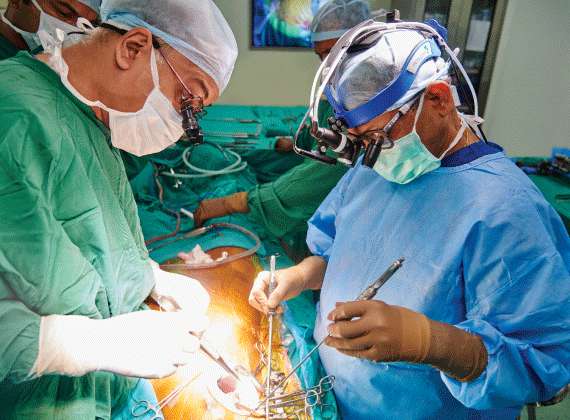The safest bariatric surgery depends on various factors, including the patient’s health condition, age, weight, and medical history. However, when considering safety, there are a few common bariatric surgeries that are typically seen as low-risk options with a strong safety profile:
1. Gastric Sleeve Surgery (Sleeve Gastrectomy)
Bariatric surgery in Abu Dhabi is considered one of the safest bariatric procedures. It involves the removal of a large portion of the stomach, leaving behind a small “sleeve” that limits the amount of food a person can eat. The procedure is minimally invasive and performed laparoscopically, which reduces recovery time and complications. This surgery is effective for significant weight loss and has a lower risk of complications compared to other more invasive procedures like gastric bypass.
2. Adjustable Gastric Banding (Lap-Band)
Adjustable gastric banding is another relatively safe bariatric surgery. It involves placing a silicone band around the upper part of the stomach, creating a small pouch that restricts food intake. This procedure is reversible and can be adjusted to ensure optimal weight loss. However, it is less commonly performed today, as other options like gastric sleeve surgery often provide more sustainable results. The risks associated with the band, such as slippage or erosion, can be a concern, but overall, it has a low complication rate when compared to more invasive surgeries.

3. Gastric Bypass (Roux-en-Y)
Gastric bypass surgery is a more complex procedure and has a slightly higher risk profile compared to gastric sleeve or adjustable banding. It involves creating a small stomach pouch and rerouting a portion of the small intestine. While it can lead to significant weight loss and improvements in obesity-related conditions like diabetes, it is more invasive and carries a higher risk of nutritional deficiencies, dumping syndrome, and other complications. However, it is still considered safe when performed by experienced surgeons.
4. Endoscopic Sleeve Gastroplasty (ESG)
Endoscopic sleeve gastroplasty is a newer, non-surgical option that uses an endoscope to stitch the stomach into a sleeve shape without making any incisions. This minimally invasive technique has a lower risk of complications and requires a shorter recovery time compared to traditional surgery. It’s an option for patients with lower BMI or those who are not candidates for more invasive procedures.
Factors Affecting Safety
The safety of any bariatric surgery depends on:
- Patient’s overall health: Conditions like heart disease, diabetes, and other chronic illnesses may affect the surgical outcome.
- Surgeon’s expertise: The experience and skill of the surgeon play a significant role in minimizing complications.
- Post-surgery care: Adhering to dietary and lifestyle recommendations post-surgery is critical for long-term success and safety.
Conclusion
When it comes to bariatric surgery, the “safest” option varies depending on the patient’s individual health conditions, needs, and goals. However, among the most commonly performed procedures, gastric sleeve surgery is often considered one of the safest due to its minimally invasive nature, effective weight loss results, and relatively low risk of complications. Adjustable gastric banding can also be a safe choice, particularly for patients seeking a reversible option, though it’s less commonly used today. While gastric bypass surgery offers significant weight loss benefits, it is more invasive and carries a higher risk of nutritional deficiencies and complications. Endoscopic sleeve gastroplasty (ESG), a newer non-surgical procedure, is another promising option with a low risk profile, though it’s best suited for certain patients.
AQs
1. What is the least invasive bariatric surgery?
The least invasive bariatric surgery is Endoscopic Sleeve Gastroplasty (ESG), which does not require any incisions. It is performed using an endoscope and stitches to reshape the stomach, offering a less invasive alternative with shorter recovery time.
2. How long does recovery take after gastric sleeve surgery?
Recovery time after gastric sleeve surgery typically ranges from 2 to 4 weeks. Most patients can resume light activities after 2 weeks, but full recovery, including resuming intense physical activities, may take up to 6 weeks.
3. Are there risks associated with bariatric surgery?
Yes, all surgeries carry some level of risk. For bariatric surgery, common risks include infections, blood clots, leaks, and nutritional deficiencies. However, the risk of serious complications is minimized with proper care and choosing an experienced surgeon.
4. How do I know which bariatric surgery is right for me?
The best type of bariatric surgery for you depends on factors such as your BMI, overall health, and personal goals. A consultation with a qualified bariatric surgeon will help determine the most suitable procedure based on your medical history and weight loss objectives.
5. Can bariatric surgery be reversed?
Some procedures, like adjustable gastric banding, are reversible, while others, like gastric sleeve surgery and gastric bypass, are permanent. It’s essential to understand the implications of the surgery you choose and discuss options with your surgeon to make an informed decision.
6. How much weight can I expect to lose after bariatric surgery?
The amount of weight loss varies by procedure and individual factors. On average, patients can lose 60-80% of their excess weight within the first 12-18 months after surgery. However, maintaining a healthy diet and regular exercise is key to achieving long-term success.
7. Can I get pregnant after bariatric surgery?
Yes, many women can get pregnant after bariatric surgery. However, it is generally recommended to wait at least 12-18 months after surgery before trying to conceive. This allows your body to stabilize and ensures that you are maintaining proper nutrition levels to support a healthy pregnancy.
